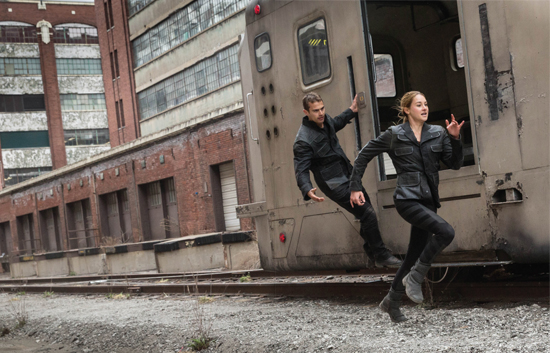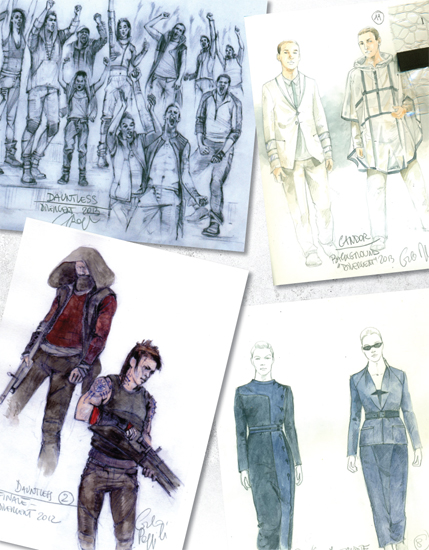
SCOUTING LOCATIONS
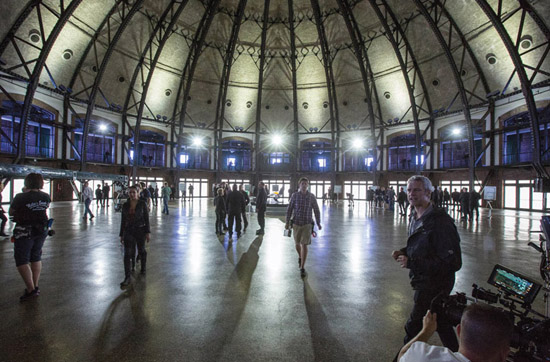
The Navy Pier Grand Ballroom is the setting for the final test of the fear landscapes.
Location manager James McAllister had been working around the clock. “I would say we probably scouted a hundred or more locations, and used about half,” he says. “Neil was trying to find a lot of places that you would still see a hundred and fifty years from now, but used in a different way. The plaza we used for the high school, at the Michigan Avenue Bridge, is in a location that could still be a center of the city, well into the future. If a location felt too much like it had been seen in other films, though, Neil wanted to stay away from it, or look at it from a new perspective.”
As McAllister scouted for locations, he kept in mind what the filmmakers would need to do to transform them for shooting. He explains, “We discussed the city streets and how best to give them the look of a hundred and fifty years from now. What kinds of present-day elements would we have to deal with? Traffic signals, lines in the streets, trash cans, bike racks, city street signs . . . all those things would have to go.” Since the future in Divergent would be mostly free of cars, the production team would need to make the streets look unused or in disrepair, so ordinary items like signs and crosswalks would be extraneous. Some would be removed before the shoot, and some would be removed much later, in postproduction by a team led by visual effects supervisor Jim Berney.
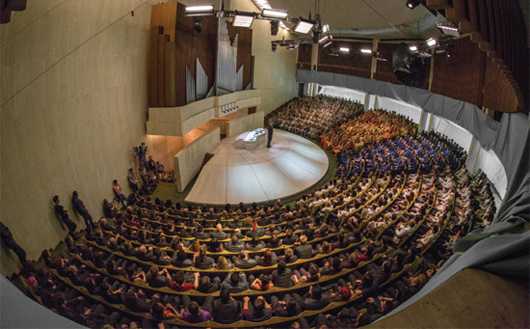
The Seventeenth Church of Christ, Scientist, is the setting for the Choosing Ceremony.
“The visual effects in Divergent are subtle. We’re taking the real city of Chicago a little bit into the future, but not so far out that your brain can’t really wrap around it, but just enough to where it makes it a little eerie,” says visual effects supervisor Jim Berney.
Chicago offered a broad range of places to choose from. In a city that grew from an industrial powerhouse to a world capital, there were a variety of opportunities. McAllister remembers, “Because of the position of Chicago in the Industrial Revolution, there was a lot of that type of structure here. Heavy steelwork and brick and big old factories. And because of the forward motion of the city, there’s new and glossy, so you can get that, too.”
One by one, he and Burger identified locations where they could shoot scenes. The Seventeenth Church of Christ, Scientist, in downtown Chicago, would make a majestic Choosing room. The Mansueto Library, at the University of Chicago, would be perfect for the Erudite library. The Ferris wheel at Navy Pier, a key part of Roth’s story, would be available for the team to use—and so would the Grand Ballroom at the end of the Pier, which would accommodate an intimidating fear landscape.
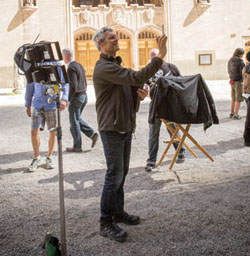
Director Neil Burger visualizes a shot.
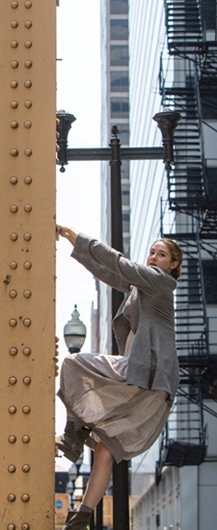
Tris (Shailene Woodley) climbs the El structures leading to the trains.
At the same time, McAllister was starting to get a sense of what the film crew could shoot within the Chicago system of elevated trains—the Chicago “El.” He recalls, “We had lengthy meetings with the transit authority, to talk about what we could and couldn’t do on their property. We were able to start some of the climbing up the El structures, with very strict parameters on how high we could get and how many columns and distances from power lines.”
As the scouting process wore on, and Neil Burger’s team was in place, it became clear that the city would not offer perfect locations for every scene. Those that couldn’t be shot at an existing site would be shot at sets they would build from the ground up. Many of them could be created at Cinespace, an enormous film production complex on the city’s west side that offered cavernous spaces, paint and carpentry shops, and ample room for storage.
Whether they were looking at locations or planning sets, the filmmakers did painstaking planning before they brought in any cameras. Early in the process, production designer Andy Nicholson worked with a concept artist to create images of everything from the Dauntless headquarters to the skyline of Roth’s future Chicago. “We needed to know what we were talking about—when we were standing on the street location, eventually, with cameras and costumes.”
In addition, Nicholson did elaborate digital modeling of every set that was to be built. He explains, “With any set, the starting point is always to make a 3D model of it on a computer because you can fly around it. You can put film lenses on it. You can do time-of-day studies for it. And all of those things become incredibly important when you’re spending a large amount of someone else’s money, say, building a big village outside. It’s important that it works practically for shooting.”

Chicago of the future.
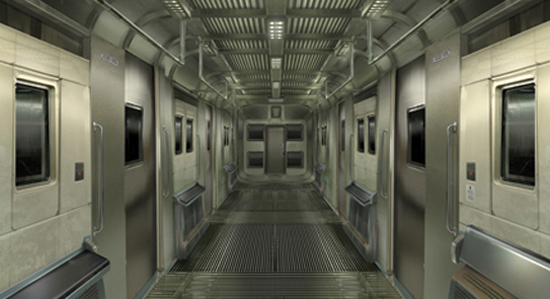
A 3D model of one of the El trains.
A HOME FOR EACH FACTION
One of the filmmakers’ biggest challenges was distinguishing the identities of the different factions and conveying critical information about them from visual clues. Each faction’s living and working quarters, costumes, and makeup needed to reflect and communicate their core values. In the film, audiences see how Abnegation and Dauntless live, with just a glimpse of Erudite and the factionless (and none of Amity or Candor at all). Burger and Nicholson imagined what the homes of each faction would look like. The Abnegation and Dauntless headquarters were the two largest sets the team built.
Production designer Andy Nicholson remembers, “One of the things we definitely tried to do with the creation of the factions was make them each appealing in their own way. Dauntless is obviously appealing. It’s an exciting, dangerous, dynamic place to be. You kind of like the idea of Erudite as a place, even though they are the villains in the piece. And Tris finds Abnegation comfortable and calming until the moment she leaves—we hope that some people will watch the movie and think, Well, why did she leave Abnegation? It was kind of nice.”
Amy Newbold, who plays Molly, remembers feeling a strong reaction to the locations chosen for the Dauntless compound. “These people are living in this completely utilitarian world where there’s no frills,” she explains, “yet everything was so detailed in these super cold warehouses.”
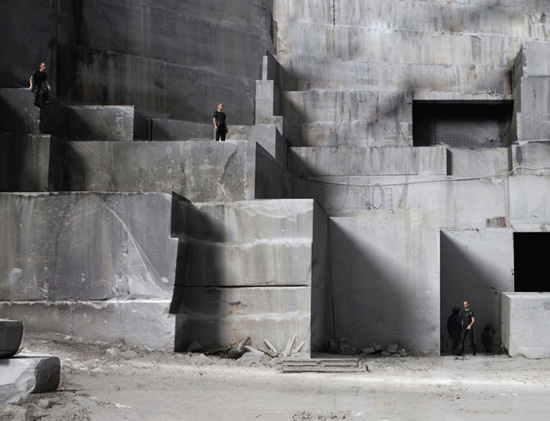
A 3D model of the Dauntless Pit.
THE ABNEGATION VILLAGE
No location in Chicago lent itself naturally to an Abnegation neighborhood, so Burger and Nicholson agreed that they’d have to build one from scratch. The question was how to do it, and where. Ideally, they’d have space to create a group of Abnegation houses, where they could shoot exteriors for both the peaceful beginning and the violent end of the movie. The complex at Cinespace was an amazing resource for the film team, but it wasn’t big enough to accommodate the final battle scene.
Executive producer John Kelly remembers, “So we came to Chicago, our first time out. Neil and I went up to the top of the Willis Tower—the Sears Tower. We stood on the 113th floor, the antennas are above us about three hundred feet high. And Neil looks down and he sees this little piece of ground maybe a mile away from the location we’re at, and he goes, ‘That’s where we’ll build Abnegation.’ And I’m like, ‘Well . . . if we can afford it. . . .’ I didn’t think it would work. It’s a prime piece of land in downtown Chicago! But we got the location, and that’s where we built our town. A humble Abnegation village in the shadow of one of the largest buildings in the world.” Even though they were building a set, they were still taking full advantage of the city’s best features.
The village was made up of a dozen compact gray houses with a simple, contemporary design. In the movie, it would look as if they were made from poured concrete, but they were really built from plaster, with decorative finishes. They were the very model of Abnegation’s simplicity and modesty.
Creating the Abnegation village turned out to be an enormous task, involving three solid months of construction at the site. When it was finished, Burger’s first instincts turned out to be dead-on. “The fact that it’s a vacant property right on the edge of downtown, that was the big attraction to Neil,” location manager McAllister explains. “We had looked at some other vacant land, six to eight blocks away, but it just gave a different perspective. That location, the city is right there, and it really fills the frame.” Because the construction was out in the open, fans discovered it and came to watch the houses going up. Passersby who didn’t know about Divergent, though, thought a new apartment complex was being built.

The Abnegation village with the Willis Tower in the background.
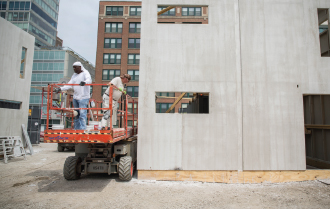
Building the Abnegation village.
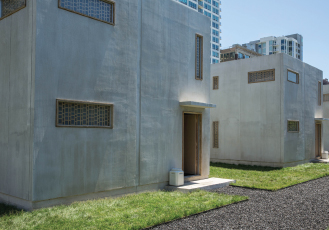
An Abnegation home.
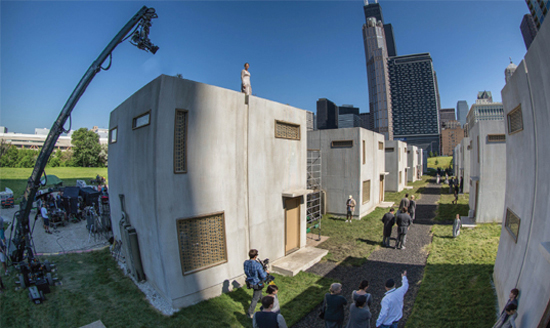
Filming Shailene Woodley (Tris) atop the roof of the Priors’ house.
INSIDE THE PRIORS’ HOME
At Cinespace, another crew created the interior of Tris’s house, which was modified to serve as the interior of other Abnegation houses as well. Set decorator Anne Kuljian explains, “What we’ve tried to do with the Abnegation set is reduce living to basic, common needs and necessities. One room functions as the dining area, the living area, and a working area for the family. The only other areas in the house are the kitchen and the bedrooms. So pretty much you’re in this room 24-7 if you’re home. We tried to set it up so that different activities could take place on one giant table. Sometimes eating, sometimes working, sometimes just talking. The confined set reflects the way the Abnegation think. Everything is very tight, and they live as a family unit.”
The houses’ color scheme also reflects the Abnegation aesthetic, Kuljian continues. “We tried to keep the elements at their most raw, and the color tones at their simplest. So we have the cool grays and we have the warm beige of the ash wood that we used quite a lot in this set. The set has a certain warmth, but it definitely feels minimalistic.”
Even the floor of the house was emblematic of Abnegation’s dedication to simplicity and recycled materials. Producer Lucy Fisher was on the set one day. “And there was this band of construction people in the Prior house, all excited. I came over and they were all beaming, so I said, ‘What’s going on?’ They just said, ‘Look at the floor.’ And it was made up of a jigsaw puzzle of little pieces of wood, that supposedly would have been leftover pieces, and they perfectly fit. It was an exquisite floor, and it was so great because they were into the storytelling, too. They understood that the lock of Tris’s hair would be cut and fall to that floor.”

Neil Burger directs the dinner scene at the Priors’.

Shailene Woodley (Tris) and Ashley Judd (Natalie Prior) chat between takes. To their left are director of photography Alwin Küchler and director Neil Burger.
THE DAUNTLESS COMPOUND
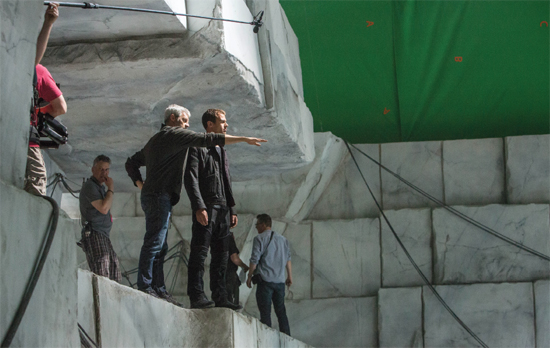
Director Neil Burger prepares Theo James (Four) for a scene in the vast Dauntless Pit.
If the Abnegation set felt minimalist, the Dauntless set would need to feel raw yet vibrant. One challenge, though, was that it was also supposed to be underground. At first, production designer Andy Nicholson imagined a dark set, like a cave, but he knew it would be difficult to film in that kind of a space, since the characters would need to be lit while the background remained murky. Eventually Nicholson came to a novel idea. Rather than making the Dauntless headquarters a dark cave, he would make it a cave carved from marble or limestone.
Theo James, who plays Four, says, “When I read the book and the script for the first time, I thought of the cavern as a dark place. Wet and cold. And I wondered what drew the Dauntless there. It seemed so inhospitable, like they’d be cold all the time. Then Neil said that the white marble creates a sense of warmth, visually. And you really need that if you are going to buy into this world.”
While the Pit, as the filmmakers called it, would look like it was underground, it was actually built on a massive soundstage at Cinespace. The construction required great time and effort, but the Pit had to be large enough to convey the freedom of the Dauntless, in contrast with the cramped Abnegation houses.
Dauntless group scenes would be filmed in the Pit and be augmented with scenes shot at locations and sets styled to look like they were part of the same whole. Production designer Andy Nicholson explains, “You have a whole series of spaces that really have to work together for many different scenes and be identifiable and be interesting enough so it just doesn’t look like you’re shooting against walls without any background. So the corridors have very specific structures. It’s very important for an audience to know where a character’s gone to or come from.”
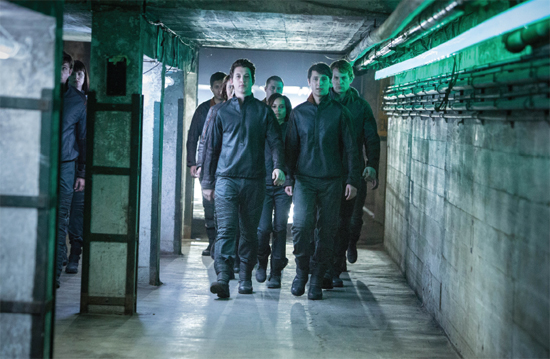
In the Dauntless tunnel.

Shailene Woodley (Tris) gets her makeup touched up by makeup department head Brad Wilder and key makeup artist Denise Paulson.
Location manager James McAllister adds, “The whole Dauntless environment was tricky, because there were so many areas and elements to it. We needed to piece them all together so they meshed, while at the same time taking care not to make it all feel monotonous. Going to the dorm to the dining hall to the tunnel—each place had to look a little different.” Different kinds of lighting, particularly LED lighting, helped to create these separate areas.
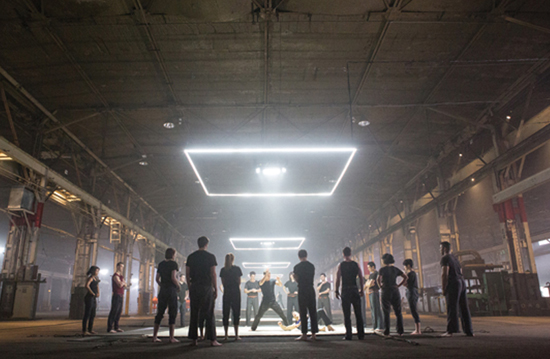
“THE FIGHTING ARENA WAS JUST ABOUT THE CHANCE TO USE A SPACE OF THAT SIZE AND TO TAKE ADVANTAGE OF THE PERSPECTIVE IT OFFERS. IT’S VERY INTERESTING TO BE IN A PLACE OF THAT SCALE WHEN IT HAS NOTHING IN IT AT ALL, BECAUSE PEOPLE REALLY DO DISAPPEAR AT THE OTHER SIDE OF THE BUILDING.”
—PRODUCTION DESIGNER ANDY NICHOLSON
THE DAUNTLESS DINING HALL
While postproduction work would make it seem like the dining hall was within the Dauntless Pit, it was actually filmed at an entirely different location. “We went through several different choices before we found something that wasn’t too big and wasn’t too small to work,” remembers Andy Nicholson. “We settled on the location we used because it had a fantastic ceiling light, and it was in a really great room that had two levels. It was enough to contain, I think, two hundred people without being enormous and without cramming them in too much. And there were areas you could come out of complete darkness into. It was like coming out of the cave and into this light area. That was what inspired us.”
Location manager James McAllister adds, “It was a former athletic club from just after the turn of the century that had an indoor swimming pool with a track, but had long since been abandoned. When we scouted it, there was snow on the roof and leaking near the skylight, so we did some repairs. But of course the week that we shot the location we had probably the worst rainstorm in three years. It became an around-the-clock job, making sure the location was filmable, just keeping the water out.”
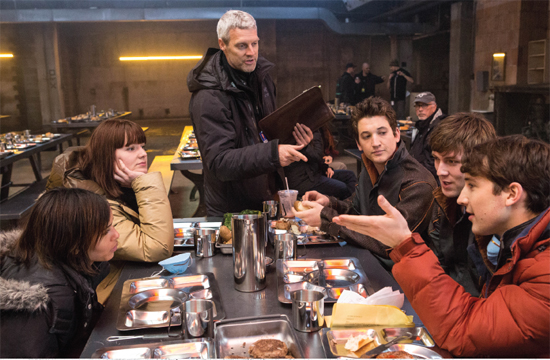

Director Neil Burger discusses a scene with the cast and crew.
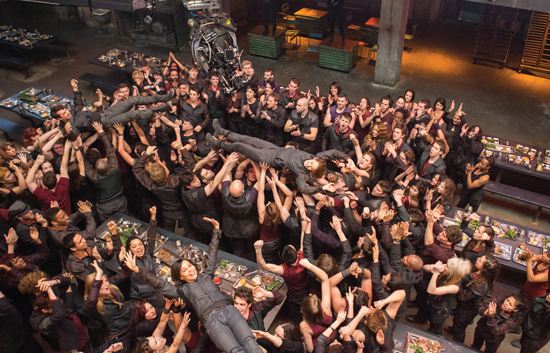

Director of photography Alwin Küchler gets a close-up of Amy Newbold (Molly).
THE DORMS
The Dauntless initiates live in the cold dormitory inside the Pit, all shiny surfaces and open space. There’s no privacy here for the newcomers, not even in the bathrooms.
“The transfer dorm has the discomfort factor, which is helpful,” recalls Amy Newbold. “There’s such a clear vision for this Dauntless world that’s shown up in every set. The dorms are super minimalistic and only have necessities.”
“THE DAUNTLESS WORLD IS SO MINIMAL—SO RAW AND DIRTY AND GRITTY AND DARK.”
—AMY NEWBOLD (MOLLY)

Collaborating on a scene featuring Shailene Woodley (Tris): (L to R) B Camera/Steadicam operator Dave Thompson; director of photography Alwin Küchler; camera operator Martin Schaer; and director Neil Burger.
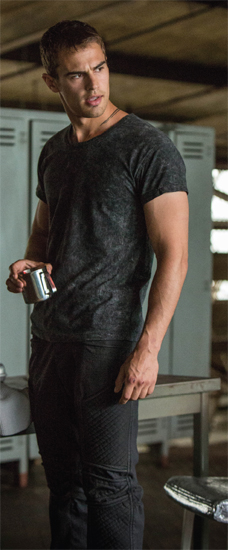
Four (Theo James) in his apartment.
FOUR’S APARTMENT
While the initiates live in the dorm, those who have made it through initiation can live wherever they want. When Tris and Four are together in Four’s apartment, it’s one of the first times they have a chance to be alone. Divergent book fans were especially eager to know what Four’s apartment would look like.
Director Neil Burger says, “Four’s found a cool space aboveground that he’s pulled together in a pretty great way.” Andy Nicholson searched all over Chicago because, as he puts it, “I wanted to have somewhere that was semi-industrial but not completely. Eventually we discovered a fantastic mezzanine over a recording studio, which had a hundred-foot window down one side, which we treated the glass on. Then I just brought in some natural tin ceiling panels to use as walling and stuff like that. It had to be comfortable, romantic, and very uniquely his. It was as far from the dorm as we could get it.”
It was Anne Kuljian’s job to create the interior design for the apartment. She gave Four a random assortment of items he could have gathered from around the city. She explains, “The Dauntless can collect things from different parts of the past, and they can bring things together. Their look is much more eclectic, and their colors are much brighter.”
Neil Burger says, “The Dauntless are really good scavengers as well as being good fighters. They’ve kind of cherry-picked all the coolest leftovers, whether they’re furniture or lamps or other pieces of things, and brought them together into their world.”
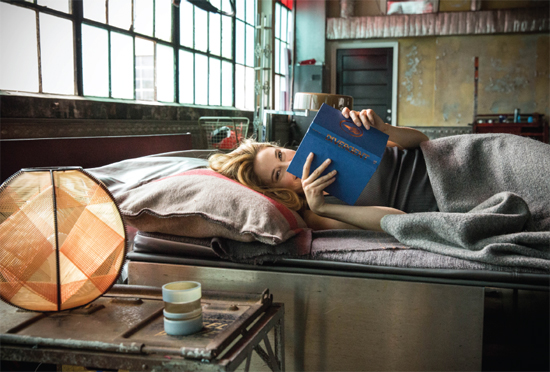
Shailene Woodley (Tris) reads Divergent on the set of Four’s loftlike apartment.
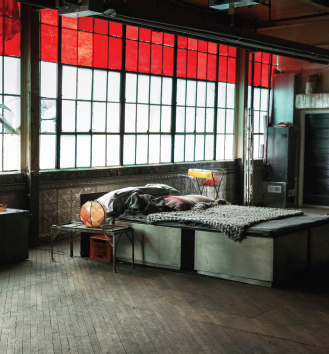
Four’s place—away from the dorms.

FEAR SIMULATIONS
Because the fear simulation sequences play such an important role in developing the characters of Tris and Four, Burger wanted to set them apart, visually, from the rest of the film, without doing anything that would be disruptive to the viewer. After experimenting with some options, he decided to shoot these scenes with an anamorphic lens that would distort the images slightly. Anytime Tris is under the influence of a serum—whether it’s during the aptitude test or during her Dauntless initiation—the audience sees her world through the anamorphic lens. The viewer won’t even realize what is off about the image at first, just that it is different from the images that came immediately before.
Although the Dauntless simulation room is small and simple, it feels dramatic. The image of a single chair in a cold environment is striking. Veronica Roth remembers the emotional impact of seeing it for the first time. She says, “It’s weird, but the coolest day that I had was seeing the simulation room, which is funny because that’s basically just a room with a chair in it, and a computer, and a syringe, and that’s all. But the chair was this kind of gross orange color, and it had this ominous headpiece to keep people’s heads in place. And then the syringe was this elaborate-looking torture device, and it was terrifying. I realized that every little detail of this is working together to make this situation seem as frightening to the audience as it is to the person sitting in the chair.”
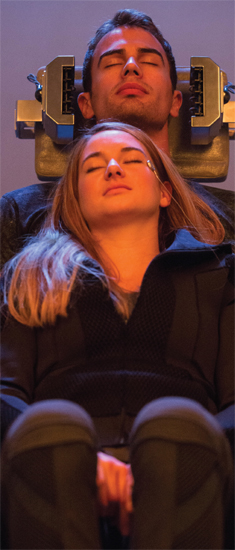
Tris (Shailene Woodley) and Four (Theo James) during a fear simulation.
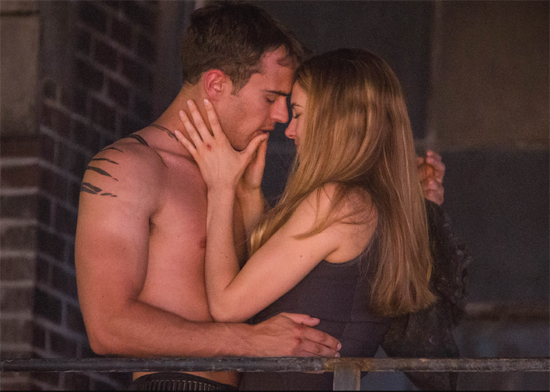
Tris (Shailene Woodley) and Four (Theo James) enact one of Tris’s fears: becoming intimate with Four.
In addition, Nicholson designed the simulation sequences so that each would take place in a smaller, more constrictive space, until he opened up into the final sequence, the fear landscape, which would be in a space many times bigger than the rest. “The only way you can visually sell that kind of idea onscreen,” he explains, “is if you have a progression that’s such a shock that it makes it all worthwhile.”
The room where the characters wait before going into the fear sim room is small and linear, with a symmetrical light source. The fear sim room itself is only slightly bigger, with a couple of unusual details, like slanting doors, that the viewer won’t really notice until Tris walks through them. She walks through a narrow corridor that opens up, then, into the larger fear landscape room, where she will face crows, a tank of water, the threat of being burned alive, the prospect of sex with Four, and the horrific task of killing her own family.
The fear landscape was filmed on location at the end of Chicago’s Navy Pier, a landmark that stretches a mile out into Lake Michigan. Under a massive, eighty-foot dome sits one lone chair for Tris to settle into before the simulation begins. Audiences will feel her discomfort from the moment she sees the looming space and waits for the simulation to begin.

THE FENCE
In Roth’s novel, Andy Nicholson points out, you never know whether the fence around the city is keeping people in or keeping people out. You know it is there, but you don’t know its size or function.
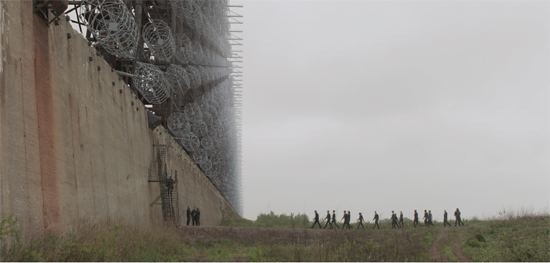
The wall patrolled by Dauntless.
For the purposes of the film, Nicholson decided to make it a more striking feature. “I found a reference, a radar installation in Russia,” he says, “which kind of sparked a lot of conversation. It became the basis for something that was so big that you didn’t know what it was.” There was only one problem. Could they find such a fence in real life?
Executive producer John Kelly tells the story like this: “In the book, there’s a scene where the Dauntless initiates go to the fence and they climb up and they see outside of the city walls. I figured we’d be building something twenty-five feet high that looked like a big cement wall. But Neil said no, let’s find a big wall. Okay. Problem is, there’s no forty-foot wall in Chicago.” Sure enough, though, location manager James McAllister managed to find a concrete wall—inside the city—that ran about a quarter of a mile long. Kelly continues, “So we get out there and it’s part of an old steel factory, where they held a lot of materials that went into the manufacturing of steel. The wall is probably about forty feet high, probably fifteen feet wide, and is the perfect base for our walled city.”

Dauntless initiates reach the wall.
THE TRAINS

Filming special effects train scenes using green screen.
Since there are few cars in the future Chicago of Divergent, trains are the main form of transportation. They take characters between the factions’ different areas, circling the city in an endless loop.
When the film crew began discussion of how to handle the train sequences, they planned to create a train that could travel on the existing Chicago El tracks and structure. When they realized the number of practical problems that would cause, however, they decided to build their own train and sections of track instead. The train car was built on top of a bus chassis, which made it easy to move it from place to place.
In addition, they also built a small section of El structure, for when the Dauntless climb up and wait for the train. Location manager James McAllister says, “We put our section of track in a canyon, so we could get some of that real city environment all around us.”
The train sequences were shot in pieces and augmented with visual effects. (Special effects are flourishes, such as lights or smoke, that are created and then filmed by a camera. Visual effects are those that must be added after the shoot. Often there is a blank spot in the film—indicated by a green screen—that indicates something to be filled in later.) Visual effects producer Greg Baxter explains, “The first train sequence, when Tris leaves the Choosing Ceremony and runs with the Dauntless, gets onto the train, takes the train to the Dauntless compound, and jumps off . . . that sequence is probably one of our most expensive visual effects sequences. We had to film it in six different places. Our job is to tie it all together so the audience doesn’t realize it was a location, and then a set piece, and then a stage, and then the back of our parking lot.”
While they didn’t always film on the real El, the actors really did jump on and off the train, and they worked hard to prepare for the train sequences.
Neil Burger planned these scenes with painstaking care. He recalls, “I sort of sketched out how I saw the scene, and these are very rough thumbnails to start with. That’s somebody grabbing a handle, running away from us; those are feet running away from us. The whole scene is in very rough storyboards. And then I worked with a guy who drew them in a quicker way, and we turned those into the pre-visualization, which basically looks like a video game, or something like that. It allows us to know where we need green screen, which parts will need visual effects, and which parts we can do for real, what we need to build and what we don’t need to build. That way, we can be really efficient when shooting. We know we’re looking from the front of the train to the back, we’re going to need some sort of green screen beyond the train because we’re going to put the city in, and sometimes we’re looking into the train so we don’t need that at all. It’s a matter of knowing what we’re going to shoot, how we’re going to tell the story, and what tools we’re going to do it with.”
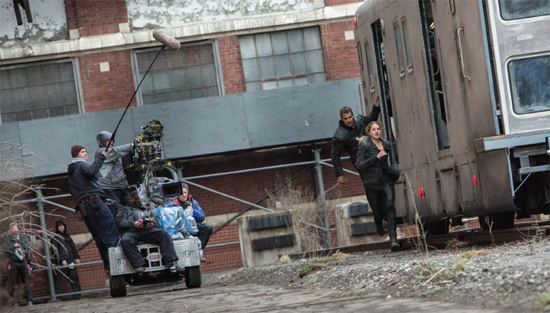
Filming a train scene with Theo James (Four) and Shailene Woodley (Tris).
